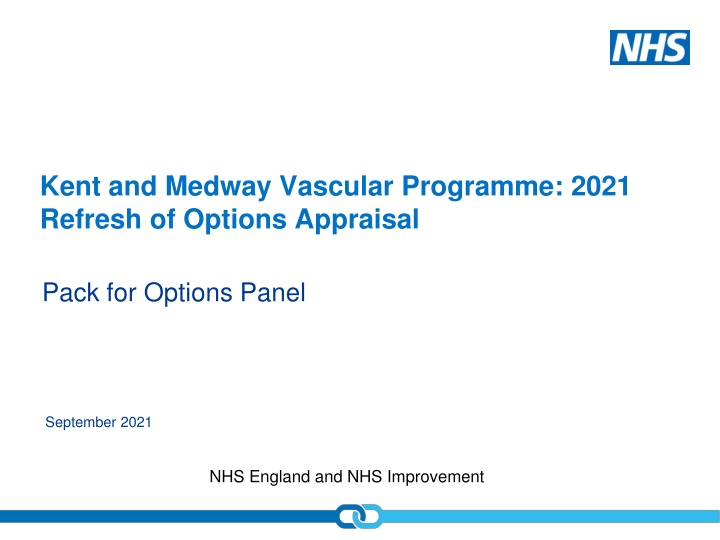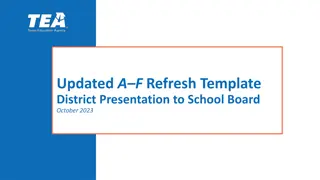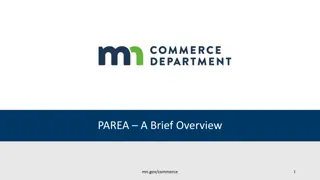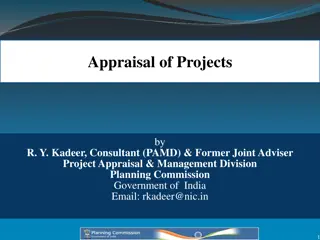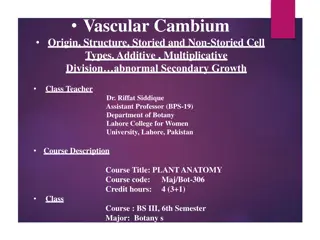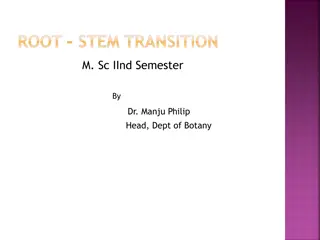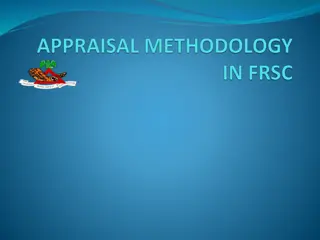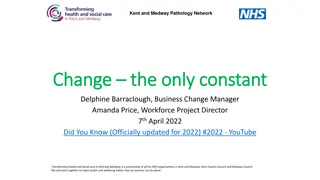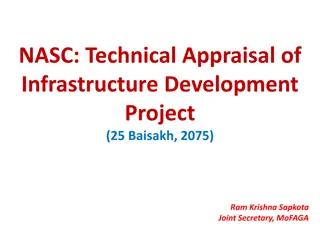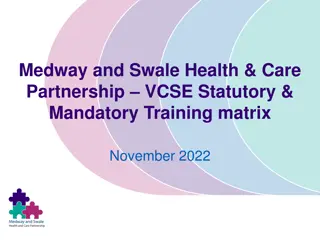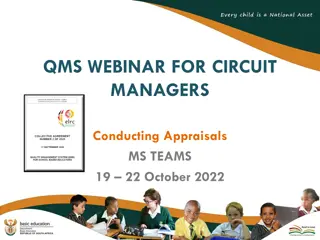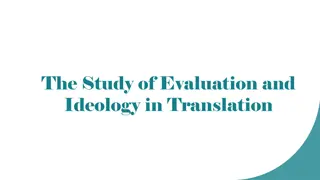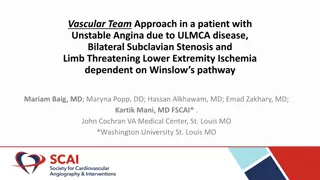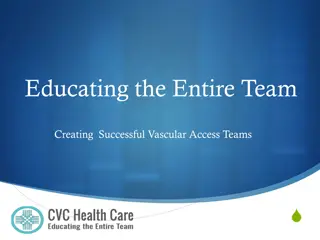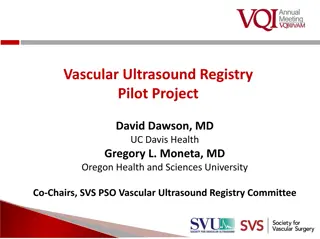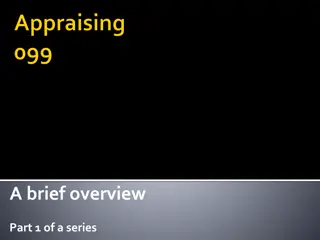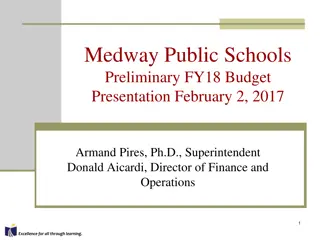Kent and Medway Vascular Programme: 2021 Refresh of Options Appraisal
The Kent and Medway Vascular Programme underwent a review in 2014 that identified the need for a different setup of vascular services due to existing providers not meeting national standards. Subsequent options appraisals in 2016 and beyond led to the recommendation of a single dedicated specialist vascular service for Kent and Medway. The location of the main arterial center is being determined through the East Kent Transformation Programme, with a focus on long-term sustainability and quality of care. Medium-term solutions are being explored to ensure service safety and continuity amidst ongoing issues.
Download Presentation

Please find below an Image/Link to download the presentation.
The content on the website is provided AS IS for your information and personal use only. It may not be sold, licensed, or shared on other websites without obtaining consent from the author.If you encounter any issues during the download, it is possible that the publisher has removed the file from their server.
You are allowed to download the files provided on this website for personal or commercial use, subject to the condition that they are used lawfully. All files are the property of their respective owners.
The content on the website is provided AS IS for your information and personal use only. It may not be sold, licensed, or shared on other websites without obtaining consent from the author.
E N D
Presentation Transcript
Kent and Medway Vascular Programme: 2021 Refresh of Options Appraisal Pack for Options Panel September 2021 NHS England and NHS Improvement
Contents Background 3 Options long list 6 Options short list 9 Criteria used for options appraisal 9 Ask of the refresh panel 12 Refreshed 2021 information available for each criteria 13 2 |
A 2014 case for change identified that a different set-up of vascular services was required in Kent and Medway The Kent and Medway Vascular review in 2014 developed a case for change for vascular services. The review identified that the two existing providers of specialised vascular inpatient care within the Kent region, East Kent Hospitals Foundation Trust and Medway Foundation Trust, were not able to deliver against either the national specialised vascular service specification or the guidelines from the national Vascular Society for Great Britain and Ireland. Specifically, neither trust were able to meet the standards in relation to: - Having a large enough population to treat - Carrying out too few or borderline numbers of core index procedures - Having too few staff, particularly consultants, to provide 24/7 on site vascular surgery and interventional radiology on-call rotas (with clinicians that are able to undertake the required minimum numbers of interventions). Further work was then undertaken to consider the options for specialist vascular services in the future and consider how these options would address the issues identified in the case for change, looking to ensure the people of Kent and Medway were able to access high quality, safe and sustainable specialist vascular services. An options appraisal exercise was carried out by the local Clinical Reference Group in 2016 which started with a long list of seven potential options, of which only two were taken forward when considered against the standards outlined above and the case for change. 3 |
A single arterial centre has been the preferred model of care since 2016, but the East Kent Transformation Programme will determine the long term location of this In 2016, the options appraisal work was presented to the JHOSC and it was recommended that a single dedicated specialist vascular service was commissioned for Kent and Medway, based on the agreed model developed by the Clinical Reference Group which adhered to national best practice. Further engagement undertaken with stakeholders to consider and discuss the model in more detail prior to presenting the recommended model to JHOSC included clinicians, patients, carers and other interested parties representing the population of Kent and Medway. Following the options appraisal work undertaken during 2017 and 2018 around the optimal sites for delivery of the clinical model for vascular services it was agreed that the permanent location of the main arterial centre (the hub) for Kent and Medway should be determined through the East Kent Transformation programme. This programme is considering the provision of a wide range of services across the East Kent area, linked to potential large-scale capital investment in a new hospital for the region. The specialist vascular hub has a number of interdependencies with other services, and therefore needs to be considered within this overarching transformation programme to ensure the longer-term provision of specialist vascular services is located in the optimal place. Due to the length of time it will take the complete the East Kent Transformation programme and given ongoing issues within the current provision of specialist inpatient vascular services across Kent and Medway, a paper was presented to the JHOSC setting out that a medium-term solution would need to be found to ensure the safety and sustainability of the service. In 2019, NHS England & Improvement undertook an options appraisal to consider how to provide a medium term solution that would deliver a safe and sustainable specialist vascular service (the arterial hub) whilst the East Kent Transformation Programme progressed. 4 |
Changes to services since previous options appraisal Due to the COVID-19 pandemic, transformation work on the Kent and Medway vascular programme was paused for much of 2020. During this time, services at Medway hospital became increasingly challenged due to a shortage of consultant staff and additional consultant support was provided by EKHUFT in order to maintain safe services on both sites. On the 6 January 2020, MFT implemented an emergency move of all elective and non-elective AAA surgery to Kent and Canterbury Hospital. This has helped stabilise the vascular surgical services at MFT and ensured the safety of the most high-risk surgical patients. This emergency move remains in place to date and making this move permanent is now part of the proposal that we are consulting on. If the option of siting the medium term arterial centre at Medway Hospital was preferred, the emergency move of AAA surgery would be ended and the service would return to Medway hospital. Since early 2021 vascular service provision at MFT has become further challenged due to staff isolating and absence during the COVID-19 pandemic and, at the request of NHS England specialised commissioning, EKHUFT has been providing additional on-call consultant support to allow a 24/7 presence to be maintained at MFT. Since this time, the Kent and Medway vascular network has been operating more closely in line with the national recommendations, albeit as a temporary measure, and with some inpatient procedures continuing to happen on more than one site. This model of network working would continue under either of the two options being considered. 5 |
Hurdle criteria were identified based on the case for change and these are still relevant in 2021 Initial hurdle criteria for options identified from the case for change (all from the NHS England National Service Specification and the Vascular Society Guidance): These hurdle criteria are still relevant, as the two documents referenced are still the key standards that vascular services should work to. 1. Minimum population volumes (800,000 per arterial centre) Minimum procedures undertaken (a minimum of 60 AAA and 40 carotid procedures per annum. Each surgeon should undertake at least 10 AAA procedures per annum) Minimum staffing numbers for consultant surgeons and interventional radiologists (a rota of at least 1:6 for each) Specialist facilities including dedicated hybrid theatres and wards Ability to meet targets for key outcome measures (access to highly specialised interventions such as thoraco-abdominal aneurysms) Working within a network, using a hub and spoke delivery model 2. The programme team have also added an additional hurdle criteria, which we believe was implicit in the original case for change and options appraisal (which concluded that an arterial hub would have to be provided within Kent and Medway). 3. 4. 5. This is that the option must: 7. Provide access to a vascular arterial centre for the whole of the Kent and Medway population (measured by providing access within a 60 minute travel time* for the whole area.) 6. Hurdle criteria are assessed on a pass or fail basis. 6 | * Recognised as a reasonable timeframe for access to specialist care in an emergency situation
The long list of seven options was reduced to a short list of one option when reviewed against these criteria For completeness, a refresh of this process has been completed and is shown along with the original options appraisal outcome. Option Original options appraisal 2021 refresh 1 (No change) - Two arterial hub sites in Kent and Medway, retaining flows into London Doesn t meet minimum population volumes or minimum procedures undertaken Not taken forward Unacceptable due to excessive travel times for large parts of Kent and Medway (see travel map) 2 No arterial hub sites in Kent and Medway, with all inpatient flow into a London provider Not taken forward Pathways to London must be maintained for highly specialised procedures 3 Two arterial hub sites in Kent and Medway, removing any patient flows into London Not taken forward Pathways to London must be maintained for highly specialised procedures 4 One arterial hub site in Kent and Medway, removing patient flows into London Not taken forward Meets all hurdle criteria 5 One arterial hub site in Kent and Medway, retaining patient flows into London Taken forward for consideration Pathways to London must be maintained for highly specialised procedures 6 Two networked arterial hub sites in Kent and Medway, removing patient flows into London Not taken forward 7 Two networked arterial hub sites in Kent and Medway, retaining patient flows into London Doesn t meet minimum population volumes or minimum procedures undertaken Not taken forward 7 |
There are only two plausible locations for the medium term location of the single arterial centre Only two hospitals within the Kent and Medway region currently provide arterial vascular services; Kent & Canterbury hospital (part of East Kent Hospitals University Foundation Trust) and Medway Hospital. For completeness, we have assessed all major hospitals in the area against the essential clinical interdependencies for arterial vascular services (using the NHS England national service specification), and to confirm whether they have the essential specialist facilities required to deliver a vascular service (such as an endovascular theatre), and whether locating a single arterial centre there would result in excessive journey times for some patients (see travel map). Hospital Travel times of less than <60minutes for the whole of K&M? Essential specialist facilities required to deliver a vascular service? Relevant clinical interdependencies? Kent & Canterbury Hospital Yes Yes Yes Medway Hospital Yes Yes Yes William Harvey Hospital Yes No Yes QEQM No No No Maidstone Hospital Yes No No Tunbridge Wells Hospital No No No Darent Valley Hospital No No No Conclusion: In 2021, there are still only two plausible locations for the medium term location of the single arterial centre 8 |
We are refreshing the medium term options appraisal against the original criteria set out by the Vascular Programme Board Domain Criteria Evaluation questions/ Key Lines of Enquiry (KLOE) Does the option provide improved delivery against clinical and constitutional standards, access to skilled staff and specialist equipment, comparison of current clinical quality of sites? Which option would provide a better experience for patients using patient experience surveys and looking at the quality of the buildings and facilities? What are the clinical co-located services required for vascular and other services that required vascular inputs? Which option would provide a better clinical outcomes for patients using mortality rate and re- admission rates? Clinical effectiveness and responsiveness Patient experience Clinical co- dependencies Clinical outcomes Quality of care for all 1 Safety What is the expected impact on excess mortality, serious untoward incidents and patient harm? Do any options keep to a minimum the increase in the average or total time it takes people to get to hospital by ambulance, car (at off-peak and peak times) and public transport? What is the ability of model to facilitate 7 day services and improved access to care out of hours? Distance and time to access services Service operating hours Access to care for all 2 Which options would give people in Kent the greatest choice of hospitals for each service under consideration across the greatest number of trusts? Patient choice What is the Profit/Loss of the options? (2021 updated to reflect additional ICS system costs from change) Profit/Loss Affordability to commissioners Affordability and value for money 3 What is the affordability to commissioners? Capital cost to the system Which options would have the lowest capital costs (cost of buildings and equipment)? Does the option meet regulatory requirements e.g. surpluses generated by each Foundation Trust? (2021 updated to reflect new System Oversight Framework) Meet license conditions 9 |
We are refreshing the medium term options appraisal against the original criteria set out by the Vascular Programme Board Domain Criteria Evaluation questions/ Key Lines of Enquiry (KLOE) What is the potential impact on current medical and non medical staff and retraining / relocation required? What is the likelihood of each option to be sustainable from a workforce perspective, facilitating 7 day services and taking into account recruitment challenges and change in what work force does i.e. ability to ensure sufficient people with the right skills in the right places? What is the potential impact on staff attrition due to change? Scale of impact Sustainability Impact on local workforce 4 Workforce Expected time to deliver Co-dependencies with other strategies How easy will it be to deliver change in 3-5 years? (2021 Updated to reflect need to deliver the medium term option within twelve months) How well does each align with other strategic changes and provide a flexible platform for the future? Deliverability 5 Disruption to education & research Research and Education Which options best fit with current research and education to minimise disruption in these areas? Support current & future education & research delivery 6 Which options best support current and developing research and education? 10 |
The 2021 options appraisal refresh will collate updated information against each criteria to support assessment of each option by the panel The panel is being constituted of: Medical Director or representative, MFT Medical Director or representative, EKHUFT Medical Director or representative, MTW Medical Director or representative, GSTT Kent & Medway CCG director or representative NHS England, Specialised Commissioning director or representative Medical Director, NHS England Independent Vascular Clinician Healthwatch representative SECAmb representative NHS England, Quality team representative NHS England, Finance representative Project leads, NHS England Spec Comm and Kent & Medway CCG 11 |
The following slides set out the updated information against each criteria within the six domains The Panel are asked to review the information presented and score each option in the accompanying scoring template. There is a free text field for additional comments against each criteria which is optional for members to complete. The original scoring included options for -2, -1, 0, +1 and +2. For this refresh we are only using the scores of: 0 (this option does not meet this criteria), +1 (this option partially meets this criteria) +2 (this option fully meets this criteria) Each criteria will be scored and will be weighted equally, in line with the original options appraisal. Scores should be returned in advance of the panel and a draft conclusion developed by the programme team. The overall results will then be presented at the panel meeting. The scores will be averaged to give all members equal weighting. At the panel meeting, areas of difference in scoring will be discussed by the group (criteria where some have scored 0 and some have scored +2) or where free text comments have been made that require panel discussion. The panel will then agree on a consensus on these areas of difference and the preferred option will be confirmed and noted. Following the panel meeting, the outcome of the refreshed options appraisals will inform the developed of the Pre-consultation Business Case and required assurance processes for this programme of work. 12 |
Refreshed Information against Domain Criteria for Panel Assessment NHS England and NHS Improvement
Domain: Quality of care for all (1/2) Original Options Appraisal KLOEs Domain Criteria Does the option provide improved delivery against clinical and constitutional standards, access to skilled staff and specialist equipment, comparison of current clinical quality of sites? Which option would provide a better experience for patients using patient experience surveys and looking at the quality of the buildings and facilities? What are the clinical co-located services required for vascular and other services that required vascular inputs? Which option would provide a better clinical outcomes for patients using mortality rate and re-admission rates? Clinical effectiveness and responsiveness Quality of care for all Patient experience Clinical co-dependencies Clinical outcomes 1 Safety Criteria Option A Medium term site at Kent and Canterbury Option B Medium term site at Medway Clinical effectiveness and responsiveness CQC rating: Requires Improvement CQC rating: Requires Improvement Patient experience EKHUFT s most recent patient experience survey (July 2020) had an overall score of 7.7/10 which was About the Same as other Trusts MFT s most recent patient experience survey (July 2020) had an overall score of 7.4/10 which was About the Same as other Trusts Maximum of 601 patients (2019/20 baseline excluding day cases) would be impacted by this option Maximum of 269 patients (2019/20 baseline excluding day cases) would be impacted by this option Clinical co-dependencies Essential co-located services from national service specification (intensive care and interventional vascular radiology) available on site. Essential co-located services from national service specification (intensive care and interventional vascular radiology) available on site. NB: the majority of quality of care benefits from the changes to vascular services will come from the hub and spoke network model so these will be achieved irrespective of the location of the arterial hub 14 |
Domain: Quality of care for all (2/2) Criteria Domain Original Options Appraisal KLOEs Does the option provide improved delivery against clinical and constitutional standards, access to skilled staff and specialist equipment, comparison of current clinical quality of sites? Which option would provide a better experience for patients using patient experience surveys and looking at the quality of the buildings and facilities? What are the clinical co-located services required for vascular and other services that required vascular inputs? Which option would provide a better clinical outcomes for patients using mortality rate and re-admission rates? Clinical effectiveness and responsiveness Patient experience Clinical co-dependencies Clinical outcomes Quality of care for all 1 Safety Criteria Option A Medium term site at Kent and Canterbury Option B Medium term site at Medway Clinical outcomes Latest NVR data covering 2017 2019 does not show any significant outlying numbers for survival. Case numbers are average compared to national averages for most procedures. Elective AAA 53 cases (Survival 99.4%) Ruptured AAA 22 cases (50% EVAR) Complex cases 17 (65% EVAR) Carotid endarterectomy 46 (Survival 98%) Lower Limb Angio/Stent 314 (Survival 98.5%) Lower Limb Bypass 77 (Survival 97.3%) Lower Limb Amputation 113 (Survival 97.3%) Latest NVR data covering 2017 2019 does not show any significant outlying numbers for survival. Case numbers are below average compared to national averages for all procedures. Elective AAA 21 cases (Survival 98.4%) Ruptured AAA 21 cases (50% EVAR) Complex cases 10 (90% EVAR) Carotid endarterectomy 11 (Survival 95.9%) Lower Limb Angio/Stent 62 (Survival 98.3%) Lower Limb Bypass 130 (Survival 96.2%) Lower limb amputation 39 (Survival 100%) Safety CQC rating: Requires Improvement CQC rating: Requires Improvement NB: the majority of quality of care benefits from the changes to vascular services will come from the hub and spoke network model so these will be achieved irrespective of the location of the arterial hub 15 |
Domain: Access to care for all Criteria Domain Original Options Appraisal KLOEs Do any options keep to a minimum the increase in the average or total time it takes people to get to hospital by ambulance, car (at off-peak and peak times) and public transport? Distance and time to access services Access to care for all What is the ability of model to facilitate 7 day services and improved access to care out of hours? 2 Service operating hours Patient choice Which options would give people in Kent the greatest choice of hospitals for each service under consideration across the greatest number of trusts? Criteria Option A Medium term site at Kent and Canterbury Option B Medium term site at Medway Distance and time to access services 2015 travel time analysis shows: - MFT would have most accessibility within 30 minutes - MFT and K&C are equally accessible within 45 minutes - An MFT service would be over 60 minutes from East Coast/Thanet which has a high number of admissions from circulatory disease. - A K&C service would be over 60 minutes from Tunbridge Wells, but this has a lower number of admissions from circulatory disease 2015 travel time analysis shows: - MFT would have most accessibility within 30 minutes - MFT and K&C are equally accessible within 45 minutes - An MFT service would be over 60 minutes from East Coast/Thanet which has a high number of admissions from circulatory disease. - A K&C service would be over 60 minutes from Tunbridge Wells, but this has a lower number of admissions from circulatory disease Service operating hours With the appropriate TUPE arrangements and increased catchment population, the service would be able to facilitate 24/7 consultant led working sustainably With the appropriate TUPE arrangements and increased catchment population, the service would be able to facilitate 24/7 consultant led working sustainably Patient choice There would be no overall difference in patient choice between the two options, but fewer patients would be affected by the change (up to 269) There would be no overall difference in patient choice between the two options, but more patients would be affected by the change (up to 605) 16 |
Domain: Affordability and value for money (1/2) Criteria Domain Original Options Appraisal KLOEs Profit/Loss What is the Profit/Loss of the options? Affordability and value for money Affordability to commissioners What is the affordability to commissioners? 3 Which options would have the lowest capital costs (cost of buildings and equipment)? Capital cost to the system Does the option meet regulatory requirements e.g. surpluses generated by each Foundation Trust? Meet license conditions Criteria Option A Medium term site at Kent and Canterbury Option B Medium term site at Medway Profit/Loss High level assumptions on additional revenue required to deliver service: 342k (transitional revenue support agreed by commissioners) High level assumptions on unmitigated stranded costs at MFT: Up to 1.4m High level assumptions on additional revenue required to deliver service: 603k (no agreement yet in place to support these costs) High level assumptions on unmitigated stranded costs at EKHUFT: Up to 1.8m Affordability to commissioners The lower MFF on tariff at EKHUFT was identified in the previous options appraisal as leading to a lower cost for commissioners if the activity was delivered by EKHUFT, but this is not a significant differentiator The higher MFF on tariff at MFT was identified in the previous options appraisal as leading to a higher cost for commissioners if the activity was delivered by MFT, but this is not a significant differentiator 17 |
Domain: Affordability and value for money (2/2) Criteria Domain Original Options Appraisal KLOEs What is the Profit/Loss of the options? Profit/Loss Affordability and value for money Affordability to commissioners What is the affordability to commissioners? 3 Which options would have the lowest capital costs (cost of buildings and equipment)? Does the option meet regulatory requirements e.g. surpluses generated by each Foundation Trust? Capital cost to the system Meet license conditions Criteria Option A Medium term site at Kent and Canterbury Option B Medium term site at Medway Capital cost to the system No additional significant capital cost to the system as IR suite build covered by Trust s internal capital plan (> 100k) Could be significant additional capital cost to the system, in the region of 16m - 20m* if additional ward and critical care space needed to be built. Alternative options could include a refurb of the Ruby ward space on MFT site (although likely to be too small and also at significant additional cost). As no capital monies identified for this programme, a low capital solution would require moving of alternative services off the MFT site to enable space to be created for vascular patients. Meet license conditions The previous options appraisal did not identify any differentiating factor between the sites that would make meeting license conditions any easier or harder. In the new regulatory regime, both Trusts are receiving support as SOF 4 Trusts and both fall under the Kent and Medway ICS SOF. The previous options appraisal did not identify any differentiating factor between the sites that would make meeting license conditions any easier or harder. In the new regulatory regime, both Trusts are receiving support as SOF 4 Trusts and both fall under the Kent and Medway ICS SOF. 18 | * NB: awaiting final confirmation of potential new build/refurb costs from regional team.
Domain: Workforce Criteria Domain Original Options Appraisal KLOEs What is the potential impact on current medical and non medical staff and retraining / relocation required? Scale of impact Sustainability What is the likelihood of each option to be sustainable from a workforce perspective, facilitating 7 day services and taking into account recruitment challenges and change in what work force does i.e. ability to ensure sufficient people with the right skills in the right places? 4 Workforce Impact on local workforce What is the potential impact on staff attrition due to change? Criteria Option A Medium term site at Kent and Canterbury Option B Medium term site at Medway Scale of impact Number of staff potentially affected by TUPE: 10 NB: this is only staff who currently spend more than 50% of their time on vascular work. There would also be impact on non- vascular staff who do a smaller amount of vascular work such as interventional radiologists and ward nurses. Number of staff potentially affected by TUPE: 20 NB: this is only staff who currently spend more than 50% of their time on vascular work. There would also be impact on non-vascular staff who do a smaller amount of vascular work such as interventional radiologists and ward nurses. Sustainability Both options should be sustainable in the longer term as part of network model with a single arterial centre Both options should be sustainable in the longer term as part of network model with a single arterial centre Impact on local workforce Limited as due to interim moves of vascular activity, additional workforce has already had to be recruited at K&C More significant as due to interim moves of vascular activity, fewer staff are employed by MFT for specialist vascular services 19 |
Domain: Deliverability Criteria Domain Original Options Appraisal KLOEs Expected time to deliver How easy will it be to deliver change in 3-5 years? Deliverability 5 Co- dependencies/Alignment with other strategies How well does each align with other strategic changes and provide a flexible platform for the future? Criteria Option A Medium term site at Kent and Canterbury Option B Medium term site at Medway Expected time to deliver Able to deliver full arterial hub service from Spring 2022 with the completion of the IR suite build. Requirements for public and staff consultation timelines would be the same for both options. Timescale to deliver the full arterial hub service is likely to be longer than Spring 2022 due to the necessary capital or enabling/refurb works having to be started from scratch. With the minimum enabling and refurbishment works, and the necessary move of other services, the earliest plausible delivery date could be 2023. Requirements for public and staff consultation timelines would be the same for both options. Co-dependencies/Alignment with other strategies East Kent transformation programme has identified East Kent Hospitals University Foundation Trust as the site of a future Major Emergency Centre to include vascular services. East Kent transformation programme has identified East Kent Hospitals University Foundation Trust as the site of a future Major Emergency Centre to include vascular services. 20 |
Domain: Research and Education Criteria Domain Original Options Appraisal KLOEs Disruption to education & research Which options best fit with current research and education to minimise disruption in these areas? Research and Education 6 Support current & future education & research delivery Which options best support current and developing research and education? Criteria Option A Medium term site at Kent and Canterbury Option B Medium term site at Medway Disruption to education & research Both services are under the remit of the same Deanery and neither are a teaching hospital. There are no current major research projects that wouldn t be able to continue under this option. There are three current vascular junior doctor training posts at EKHUFT that would need to be accommodated elsewhere and covered separately by EKHUFT. Both services are under the remit of the same Deanery and neither are a teaching hospital. There are no current major research projects that wouldn t be able to continue under this option. Support current & future education & research delivery The original options appraisal felt that current and future education and research delivery would be equally good under both options. Both Trusts have programmes of work to expand research delivery over the coming years and the wider vascular network would contribute to this whichever site the hub was located. The original options appraisal felt that current and future education and research delivery would be equally good under both options. Both Trusts have programmes of work to expand research delivery over the coming years and the wider vascular network would contribute to this whichever site the hub was located. 21 |
